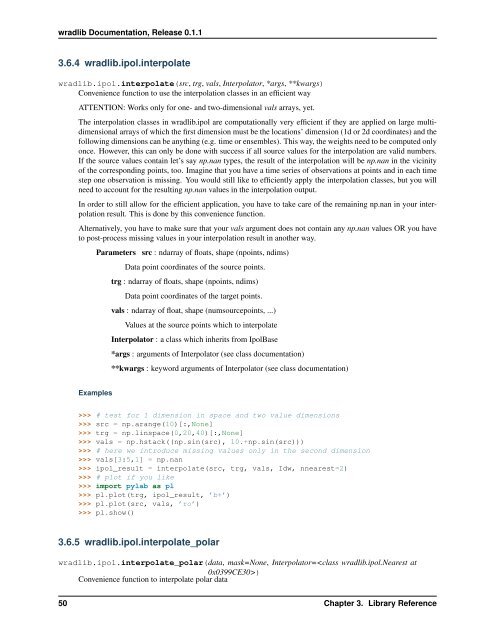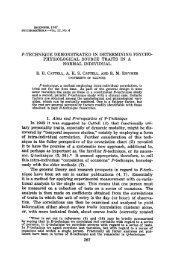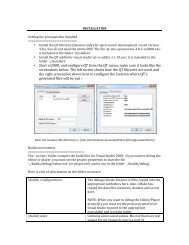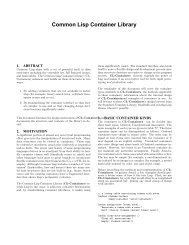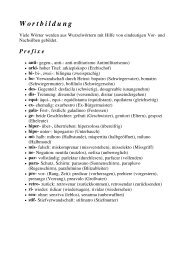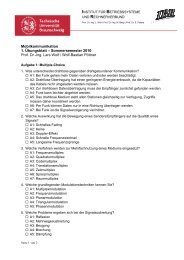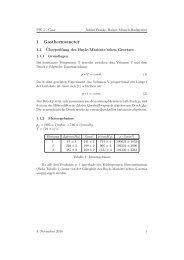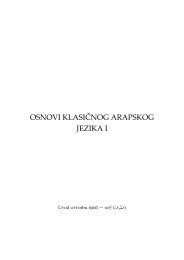wradlib Documentation - Bitbucket
wradlib Documentation - Bitbucket
wradlib Documentation - Bitbucket
You also want an ePaper? Increase the reach of your titles
YUMPU automatically turns print PDFs into web optimized ePapers that Google loves.
<strong>wradlib</strong> <strong>Documentation</strong>, Release 0.1.1<br />
3.6.4 <strong>wradlib</strong>.ipol.interpolate<br />
<strong>wradlib</strong>.ipol.interpolate(src, trg, vals, Interpolator, *args, **kwargs)<br />
Convenience function to use the interpolation classes in an efficient way<br />
ATTENTION: Works only for one- and two-dimensional vals arrays, yet.<br />
The interpolation classes in <strong>wradlib</strong>.ipol are computationally very efficient if they are applied on large multidimensional<br />
arrays of which the first dimension must be the locations’ dimension (1d or 2d coordinates) and the<br />
following dimensions can be anything (e.g. time or ensembles). This way, the weights need to be computed only<br />
once. However, this can only be done with success if all source values for the interpolation are valid numbers.<br />
If the source values contain let’s say np.nan types, the result of the interpolation will be np.nan in the vicinity<br />
of the corresponding points, too. Imagine that you have a time series of observations at points and in each time<br />
step one observation is missing. You would still like to efficiently apply the interpolation classes, but you will<br />
need to account for the resulting np.nan values in the interpolation output.<br />
In order to still allow for the efficient application, you have to take care of the remaining np.nan in your interpolation<br />
result. This is done by this convenience function.<br />
Alternatively, you have to make sure that your vals argument does not contain any np.nan values OR you have<br />
to post-process missing values in your interpolation result in another way.<br />
Parameters src : ndarray of floats, shape (npoints, ndims)<br />
Data point coordinates of the source points.<br />
trg : ndarray of floats, shape (npoints, ndims)<br />
Data point coordinates of the target points.<br />
vals : ndarray of float, shape (numsourcepoints, ...)<br />
Values at the source points which to interpolate<br />
Interpolator : a class which inherits from IpolBase<br />
*args : arguments of Interpolator (see class documentation)<br />
**kwargs : keyword arguments of Interpolator (see class documentation)<br />
Examples<br />
>>> # test for 1 dimension in space and two value dimensions<br />
>>> src = np.arange(10)[:,None]<br />
>>> trg = np.linspace(0,20,40)[:,None]<br />
>>> vals = np.hstack((np.sin(src), 10.+np.sin(src)))<br />
>>> # here we introduce missing values only in the second dimension<br />
>>> vals[3:5,1] = np.nan<br />
>>> ipol_result = interpolate(src, trg, vals, Idw, nnearest=2)<br />
>>> # plot if you like<br />
>>> import pylab as pl<br />
>>> pl.plot(trg, ipol_result, ’b+’)<br />
>>> pl.plot(src, vals, ’ro’)<br />
>>> pl.show()<br />
3.6.5 <strong>wradlib</strong>.ipol.interpolate_polar<br />
<strong>wradlib</strong>.ipol.interpolate_polar(data, mask=None, Interpolator=)<br />
Convenience function to interpolate polar data<br />
50 Chapter 3. Library Reference


